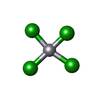[English] 日本語
 Yorodumi
Yorodumi- PDB-4hga: Structure of the variant histone H3.3-H4 heterodimer in complex w... -
+ Open data
Open data
- Basic information
Basic information
| Entry | Database: PDB / ID: 4hga | ||||||
|---|---|---|---|---|---|---|---|
| Title | Structure of the variant histone H3.3-H4 heterodimer in complex with its chaperone DAXX | ||||||
 Components Components |
| ||||||
 Keywords Keywords | CHAPERONE/APOPTOSIS / histone chaperone / CHAPERONE-APOPTOSIS complex | ||||||
| Function / homology |  Function and homology information Function and homology informationcellular response to diamide / Defective Inhibition of DNA Recombination at Telomere Due to DAXX Mutations / Defective Inhibition of DNA Recombination at Telomere Due to ATRX Mutations / neuron intrinsic apoptotic signaling pathway in response to oxidative stress / cellular response to sodium arsenite / negative regulation of chromosome condensation / Barr body / : / pericentric heterochromatin formation / inner kinetochore ...cellular response to diamide / Defective Inhibition of DNA Recombination at Telomere Due to DAXX Mutations / Defective Inhibition of DNA Recombination at Telomere Due to ATRX Mutations / neuron intrinsic apoptotic signaling pathway in response to oxidative stress / cellular response to sodium arsenite / negative regulation of chromosome condensation / Barr body / : / pericentric heterochromatin formation / inner kinetochore / muscle cell differentiation / oocyte maturation / nucleosomal DNA binding / nuclear androgen receptor binding / androgen receptor signaling pathway / nucleus organization / cellular response to cadmium ion / extrinsic apoptotic signaling pathway via death domain receptors / chromosome, centromeric region / regulation of protein ubiquitination / spermatid development / cellular response to unfolded protein / protein kinase activator activity / single fertilization / subtelomeric heterochromatin formation / RNA polymerase II core promoter sequence-specific DNA binding / negative regulation of megakaryocyte differentiation / transcription regulator inhibitor activity / protein localization to CENP-A containing chromatin / Replacement of protamines by nucleosomes in the male pronucleus / CENP-A containing nucleosome / JNK cascade / heat shock protein binding / Packaging Of Telomere Ends / Recognition and association of DNA glycosylase with site containing an affected purine / Cleavage of the damaged purine / embryo implantation / Deposition of new CENPA-containing nucleosomes at the centromere / telomere organization / Recognition and association of DNA glycosylase with site containing an affected pyrimidine / Cleavage of the damaged pyrimidine / RNA Polymerase I Promoter Opening / SUMOylation of transcription cofactors / Inhibition of DNA recombination at telomere / Assembly of the ORC complex at the origin of replication / Meiotic synapsis / cellular response to copper ion / SUMOylation of chromatin organization proteins / Regulation of endogenous retroelements by the Human Silencing Hub (HUSH) complex / DNA methylation / Condensation of Prophase Chromosomes / Chromatin modifications during the maternal to zygotic transition (MZT) / SIRT1 negatively regulates rRNA expression / HCMV Late Events / ERCC6 (CSB) and EHMT2 (G9a) positively regulate rRNA expression / PRC2 methylates histones and DNA / Regulation of endogenous retroelements by KRAB-ZFP proteins / Defective pyroptosis / HDACs deacetylate histones / Regulation of endogenous retroelements by Piwi-interacting RNAs (piRNAs) / Nonhomologous End-Joining (NHEJ) / RNA Polymerase I Promoter Escape / molecular condensate scaffold activity / Transcriptional regulation by small RNAs / Formation of the beta-catenin:TCF transactivating complex / Activated PKN1 stimulates transcription of AR (androgen receptor) regulated genes KLK2 and KLK3 / RUNX1 regulates genes involved in megakaryocyte differentiation and platelet function / HDMs demethylate histones / G2/M DNA damage checkpoint / PML body / NoRC negatively regulates rRNA expression / B-WICH complex positively regulates rRNA expression / PKMTs methylate histone lysines / DNA Damage/Telomere Stress Induced Senescence / Pre-NOTCH Transcription and Translation / Meiotic recombination / male gonad development / multicellular organism growth / Activation of anterior HOX genes in hindbrain development during early embryogenesis / RMTs methylate histone arginines / Transcriptional regulation of granulopoiesis / HCMV Early Events / osteoblast differentiation / p53 binding / structural constituent of chromatin / Regulation of TP53 Degradation / transcription corepressor activity / nucleosome / nucleosome assembly / Recruitment and ATM-mediated phosphorylation of repair and signaling proteins at DNA double strand breaks / cellular response to heat / HATs acetylate histones / RUNX1 regulates transcription of genes involved in differentiation of HSCs / Factors involved in megakaryocyte development and platelet production / MLL4 and MLL3 complexes regulate expression of PPARG target genes in adipogenesis and hepatic steatosis / chromatin organization / Processing of DNA double-strand break ends / regulation of gene expression / positive regulation of cell growth / Senescence-Associated Secretory Phenotype (SASP) Similarity search - Function | ||||||
| Biological species |  Homo sapiens (human) Homo sapiens (human) | ||||||
| Method |  X-RAY DIFFRACTION / X-RAY DIFFRACTION /  SYNCHROTRON / SYNCHROTRON /  SAD / Resolution: 2.799 Å SAD / Resolution: 2.799 Å | ||||||
 Authors Authors | Liu, C.P. / Xiong, C.Y. / Wang, M.Z. / Yu, Z.L. / Yang, N. / Chen, P. / Zhang, Z.G. / Li, G.H. / Xu, R.M. | ||||||
 Citation Citation |  Journal: Nat.Struct.Mol.Biol. / Year: 2012 Journal: Nat.Struct.Mol.Biol. / Year: 2012Title: Structure of the variant histone H3.3-H4 heterodimer in complex with its chaperone DAXX. Authors: Liu, C.P. / Xiong, C.Y. / Wang, M.Z. / Yu, Z.L. / Yang, N. / Chen, P. / Zhang, Z.G. / Li, G.H. / Xu, R.M. | ||||||
| History |
|
- Structure visualization
Structure visualization
| Structure viewer | Molecule:  Molmil Molmil Jmol/JSmol Jmol/JSmol |
|---|
- Downloads & links
Downloads & links
- Download
Download
| PDBx/mmCIF format |  4hga.cif.gz 4hga.cif.gz | 169.6 KB | Display |  PDBx/mmCIF format PDBx/mmCIF format |
|---|---|---|---|---|
| PDB format |  pdb4hga.ent.gz pdb4hga.ent.gz | 136.3 KB | Display |  PDB format PDB format |
| PDBx/mmJSON format |  4hga.json.gz 4hga.json.gz | Tree view |  PDBx/mmJSON format PDBx/mmJSON format | |
| Others |  Other downloads Other downloads |
-Validation report
| Summary document |  4hga_validation.pdf.gz 4hga_validation.pdf.gz | 677.8 KB | Display |  wwPDB validaton report wwPDB validaton report |
|---|---|---|---|---|
| Full document |  4hga_full_validation.pdf.gz 4hga_full_validation.pdf.gz | 683 KB | Display | |
| Data in XML |  4hga_validation.xml.gz 4hga_validation.xml.gz | 15.5 KB | Display | |
| Data in CIF |  4hga_validation.cif.gz 4hga_validation.cif.gz | 20.3 KB | Display | |
| Arichive directory |  https://data.pdbj.org/pub/pdb/validation_reports/hg/4hga https://data.pdbj.org/pub/pdb/validation_reports/hg/4hga ftp://data.pdbj.org/pub/pdb/validation_reports/hg/4hga ftp://data.pdbj.org/pub/pdb/validation_reports/hg/4hga | HTTPS FTP |
-Related structure data
| Similar structure data |
|---|
- Links
Links
- Assembly
Assembly
| Deposited unit | 
| ||||||||
|---|---|---|---|---|---|---|---|---|---|
| 1 |
| ||||||||
| Unit cell |
|
- Components
Components
| #1: Protein | Mass: 24805.361 Da / Num. of mol.: 1 / Fragment: HISTONE BINDING DOMAIN, UNP RESIDUES 184-390 Source method: isolated from a genetically manipulated source Source: (gene. exp.)  Homo sapiens (human) / Gene: DAXX, BING2, DAP6 / Plasmid: PGEX-6P-Xu / Production host: Homo sapiens (human) / Gene: DAXX, BING2, DAP6 / Plasmid: PGEX-6P-Xu / Production host:  | ||
|---|---|---|---|
| #2: Protein | Mass: 15360.983 Da / Num. of mol.: 1 Source method: isolated from a genetically manipulated source Source: (gene. exp.)  Homo sapiens (human) / Gene: H3F3A, H3.3A, H3F3, PP781, H3F3B, H3.3B / Plasmid: pRSFDuet-1 / Production host: Homo sapiens (human) / Gene: H3F3A, H3.3A, H3F3, PP781, H3F3B, H3.3B / Plasmid: pRSFDuet-1 / Production host:  | ||
| #3: Protein | Mass: 11394.426 Da / Num. of mol.: 1 Source method: isolated from a genetically manipulated source Source: (gene. exp.)  Homo sapiens (human) Homo sapiens (human)Gene: HIST1H4A, H4/A, H4FA, HIST1H4B, H4/I, H4FI, HIST1H4C, H4/G, H4FG, HIST1H4D, H4/B, H4FB, HIST1H4E, H4/J, H4FJ, HIST1H4F, H4/C, H4FC, HIST1H4H, H4/H, H4FH, HIST1H4I, H4/M, H4FM, HIST1H4J, H4/E, ...Gene: HIST1H4A, H4/A, H4FA, HIST1H4B, H4/I, H4FI, HIST1H4C, H4/G, H4FG, HIST1H4D, H4/B, H4FB, HIST1H4E, H4/J, H4FJ, HIST1H4F, H4/C, H4FC, HIST1H4H, H4/H, H4FH, HIST1H4I, H4/M, H4FM, HIST1H4J, H4/E, H4FE, HIST1H4K, H4/D, H4FD, HIST1H4L, H4/K, H4FK, HIST2H4A, H4/N, H4F2, H4FN, HIST2H4, HIST2H4B, H4/O, H4FO, HIST4H4 Plasmid: pRSFDuet-1 / Production host:  | ||
| #4: Chemical | ChemComp-PC4 / #5: Water | ChemComp-HOH / | |
-Experimental details
-Experiment
| Experiment | Method:  X-RAY DIFFRACTION / Number of used crystals: 1 X-RAY DIFFRACTION / Number of used crystals: 1 |
|---|
- Sample preparation
Sample preparation
| Crystal | Density Matthews: 2.35 Å3/Da / Density % sol: 47.76 % |
|---|---|
| Crystal grow | Temperature: 298 K / Method: vapor diffusion, sitting drop / pH: 7.6 Details: 0.1M HEPES-Na, pH 7.6, 23% (v/v) PEG 3350, 0.25M Ammonium acetate, 1% Tacsimate pH 7.0, 6% ethanol, VAPOR DIFFUSION, SITTING DROP, temperature 298K |
-Data collection
| Diffraction | Mean temperature: 100 K |
|---|---|
| Diffraction source | Source:  SYNCHROTRON / Site: SYNCHROTRON / Site:  SSRF SSRF  / Beamline: BL17U / Wavelength: 1.07 Å / Beamline: BL17U / Wavelength: 1.07 Å |
| Detector | Type: ADSC QUANTUM 315r / Detector: CCD / Date: Jul 11, 2012 |
| Radiation | Monochromator: Si 111 CHANNEL / Protocol: SINGLE WAVELENGTH / Monochromatic (M) / Laue (L): M / Scattering type: x-ray |
| Radiation wavelength | Wavelength: 1.07 Å / Relative weight: 1 |
| Reflection | Resolution: 2.799→50 Å / Num. all: 13301 / Num. obs: 13274 / % possible obs: 99.8 % / Observed criterion σ(F): 2 / Observed criterion σ(I): 2 / Redundancy: 7.8 % / Rmerge(I) obs: 0.083 / Net I/σ(I): 21.9 |
| Reflection shell | Resolution: 2.8→2.9 Å / Redundancy: 8.1 % / Rmerge(I) obs: 0.521 / Mean I/σ(I) obs: 1.91 / Num. unique all: 1254 / % possible all: 99.1 |
- Processing
Processing
| Software |
| ||||||||||||||||||||||||||||||||||||||||
|---|---|---|---|---|---|---|---|---|---|---|---|---|---|---|---|---|---|---|---|---|---|---|---|---|---|---|---|---|---|---|---|---|---|---|---|---|---|---|---|---|---|
| Refinement | Method to determine structure:  SAD / Resolution: 2.799→44.934 Å / SU ML: 0.34 / σ(F): 1.36 / Phase error: 24.84 / Stereochemistry target values: ML SAD / Resolution: 2.799→44.934 Å / SU ML: 0.34 / σ(F): 1.36 / Phase error: 24.84 / Stereochemistry target values: ML
| ||||||||||||||||||||||||||||||||||||||||
| Solvent computation | Shrinkage radii: 0.9 Å / VDW probe radii: 1.11 Å / Solvent model: FLAT BULK SOLVENT MODEL | ||||||||||||||||||||||||||||||||||||||||
| Refinement step | Cycle: LAST / Resolution: 2.799→44.934 Å
| ||||||||||||||||||||||||||||||||||||||||
| Refine LS restraints |
| ||||||||||||||||||||||||||||||||||||||||
| LS refinement shell | Refine-ID: X-RAY DIFFRACTION / Total num. of bins used: 5
| ||||||||||||||||||||||||||||||||||||||||
| Refinement TLS params. | Method: refined / Origin x: 39.1942 Å / Origin y: 22.8178 Å / Origin z: 150.9987 Å
| ||||||||||||||||||||||||||||||||||||||||
| Refinement TLS group | Selection details: ALL |
 Movie
Movie Controller
Controller


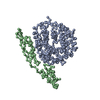
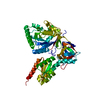
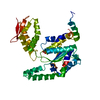
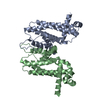


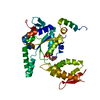


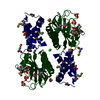
 PDBj
PDBj








